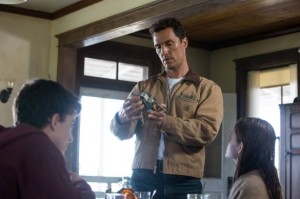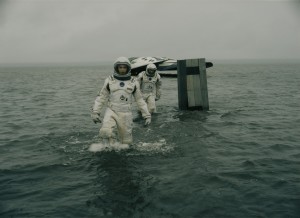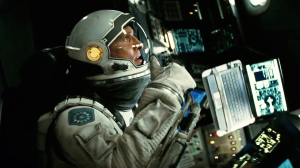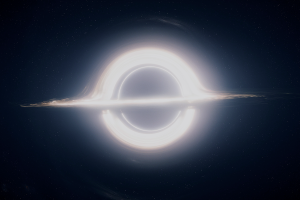By Forrest Cardamenis
In what may prove to be Interstellar’s most memorable scene, Matthew McConaughey’s Cooper (that’s a last name; curiously, he is never given a first) is transported into a teserract in which time is physically navigable. While tells TARS, a helpful robot who has been with him on his intergalactic journey, of his intention to communicate with his daughter (Jessica Chastain) and give her the information she needs to save earth’s population, which is dwindling as a result of a major food shortage and rampant air pollution. When asked by TARS how he is going to do that, Cooper responds, “Love, TARS, love.”
The scene becomes a large exposition dump—something for which writers Jonathan and Christopher Nolan are often criticized—but it is forgivable for two major reasons. First, the set-piece itself is impressive, the pièce de résistance of a film that, for its utterly uninspired screen direction (of which more later), has a number of memorable space images. Second, Hans Zimmer, doing his best work in years, even a decade, gives the scene a palpable emotional weight that would not exist otherwise. While Interstellar is unlikely to win over Nolan skeptics—his go-for-broke bombast is on its fullest display yet—it’s difficult not to at least admire the unhinged ambition on display in this particular scene.
 Less forgivable is that this scene, in which love is literally transcending time and space, occurs 90 minutes after Amelia (Anne Hathaway) gives a monologue ending with the line “love is the one thing that transcends time and space.” Leave it to Nolan, whose escalating bombastic tendencies make his closest comparison not the oft-cited (and here oft-quoted) Stanley Kubrick, but rather one of his contemporaries, Darren Aronofsky, to drill his ideas into your head and present them as revelatory despite their simplicity.
Less forgivable is that this scene, in which love is literally transcending time and space, occurs 90 minutes after Amelia (Anne Hathaway) gives a monologue ending with the line “love is the one thing that transcends time and space.” Leave it to Nolan, whose escalating bombastic tendencies make his closest comparison not the oft-cited (and here oft-quoted) Stanley Kubrick, but rather one of his contemporaries, Darren Aronofsky, to drill his ideas into your head and present them as revelatory despite their simplicity.
Both the overbearing tendency and the Aronofsky comparisons are particularly true of Nolan’s most recent films, dating back to The Dark Knight or so, in which stakes and scale escalate and his most defining traits have ceased to be formal playfulness (as was certainly the case through The Prestige and even Inception) but rather bombast. Aronofsky is equally bombastic, with The Fountain spanning millennia, featuring space and time travel, and directing its narrative with biblical quotes; Black Swan veered into camp, shock, and sudden, inexplicable bursts of sex, violence, and madness; his most recent Noah is a blockbuster-sized riff on a Biblical story that pulls from a completely separate story (that of Abraham and Isaac) and also suggests a compromise between creationism and evolution. Nolan’s bombast is most apparent in his two most recent films—The Dark Knight Rises plays for all of Gotham, virtually the trilogy’s entire world, and Interstellar plays not just for this world, but for distant corners of the universe and all of mankind. The key difference between the two directors is that in Aronofsky, bombast comes through primarily in sight and sound: The repeated, use of Clint Mansell’s harrowing “Lux Aeterna,” the increasingly frantic speed of edits, and visual hallucinations and distortions of reality in Requiem For A Dream; the cosmic imagery and recurring visual motifs of The Fountain; the screams, the bursts of violence, and, as with Requiem, the hallucinations and subjective mise-en-scene of Black Swan. By contrast, bombast in the works of Nolan are limited to their stakes and scale or other heavy-handed methods—through extended monologues that permeate his recent work like those mentioned above, or in the ending of Inception that begs you to talk about it more than it supplies meaning to the film.
In other words, Aronofsky is a good filmmaker because his bombast is, simply put, far more cinematic than Nolan’s. His bombast comes through the visual and aural senses, making use of the elements of cinema itself—mise-en-scene and editing, primarily—in order to turn the films into sensory overloads. Nolan, by contrast, is a mediocre, even a poor visual stylist. His compositions are flat and his images forgettable, his editing rhythms are jagged and disorienting without any clear motivation, and his establishment of spaces in his films is beyond lackluster, and his storytelling is less than economic, all of which is illustrated wonderfully by David Bordwell. There is minimal use of off-screen space and limited interaction between two elements within a frame. When Nolan finds a good image, he tends to skirt on past it, seemingly unaware of what he found.
 In Interstellar, most of these issues persist, namely the reliance on purely functional medium shots, the lack of off-screen space and in-frame interactions, confounding, and needlessly disorienting editing rhythms, which are particularly in the film’s extended, cross-cut climax. Central to the film’s first hour is a bookshelf, the medium through which what may or may not be ghosts communicate with Cooper and his daughter, Murph. But the titles we can see on the bookshelf—The Stand, Three Cups of Tea, One Hundred Years of Solitude, Time’s Arrow, The Wiloughbys, are so generic and scattered as to be meaningless. They do not parallel Interstellar’s own story, nor do they tell us anything about the characters. An easy opportunity to define and realize characters is completely wasted.
In Interstellar, most of these issues persist, namely the reliance on purely functional medium shots, the lack of off-screen space and in-frame interactions, confounding, and needlessly disorienting editing rhythms, which are particularly in the film’s extended, cross-cut climax. Central to the film’s first hour is a bookshelf, the medium through which what may or may not be ghosts communicate with Cooper and his daughter, Murph. But the titles we can see on the bookshelf—The Stand, Three Cups of Tea, One Hundred Years of Solitude, Time’s Arrow, The Wiloughbys, are so generic and scattered as to be meaningless. They do not parallel Interstellar’s own story, nor do they tell us anything about the characters. An easy opportunity to define and realize characters is completely wasted.
On the other hand, his spaces are coherent, and many of the outer-space images—a trip through a spherical wormhole, or a silent, extreme longshot of the spaceship floating along, for example—are beautiful. But just as often, he seems to skirt by these images in favor of what one could loosely call “storytelling.” After a trip to a planet situated near a black hole (never mind the real-life impossibility here; Interstellar’s internal sci-fi logic is generally quite strong) sees relativity work against the astronauts, Cooper finds himself with 23 years of messages from home to catch-up on. McConaughey is, for the first time in the film, given a chance to act, and the camera stays trained on his face for a relatively long time, but over-determined storytelling ruins a good image. Just as it seems the camera is going to stay there to let the grief sink-in and even encourage the audience to share it with him, a reverse shot is necessary so we can see a picture of Cooper’s grandson. We see somebody experience something but are kept at a distance, never allowed to experience it with them.
The same thing happens nearer the end of the film when Cooper takes a trip through a black-hole. The brief sequence recalls the Star Gate sequence of Kubrick’s 2001: A Space Odyssey. That sequence is one of the best ever filmed largely in part because Kubrick was not afraid to hold a shot well beyond the point of merely conveying information. We go through the Star Gate for several seconds with Dave, and the reverse-shot on his face frozen in place is likewise held long enough to encourage the same overwhelmed response, or at least to allow us to identify with his experience. Nolan, by contrast, cuts from one image to the next so quickly, moving from the black hole to the tesseract set-piece (which itself parallels the final scene in 2001) so quickly that his sequence is over when Kubrick’s might still be on the first shot.
 An insistence on storytelling is not inherently bad, but it becomes an issue particularly when the script, by Nolan and his brother Jonathan, is so riddled with problems. Beyond failing to address logical questions—why did Cooper have to leave for space that very day? Why is Cooper’s grandson given the name Cooper? Did the writers really fail to realize that makes him Cooper Cooper?—it also tends to skirt over its best ideas. When Cooper and Amelia arrive on a planet and are greeted by a long-hibernating Dr. Mann, we are met with the most interesting character in the film. He rigged his robot to say his planet is habitable to ensure somebody would come to him, and then he tries to kill Cooper, who is intent on returning home, so he can complete the mission’s “Plan B” (that is, start a colony of surrogate humans provided by NASA on a habitable planet). In this one character, then, we have the film’s entire theme about selfishness vs. preservation of the human race, someone who lied in order to end his loneliness but nevertheless risks it again to preserve humanity, but his loneliness and his relief come across purely in dialogue, and his desire to carry-on with the mission is so unclear that articles have been written asking why he tries kill Cooper.
An insistence on storytelling is not inherently bad, but it becomes an issue particularly when the script, by Nolan and his brother Jonathan, is so riddled with problems. Beyond failing to address logical questions—why did Cooper have to leave for space that very day? Why is Cooper’s grandson given the name Cooper? Did the writers really fail to realize that makes him Cooper Cooper?—it also tends to skirt over its best ideas. When Cooper and Amelia arrive on a planet and are greeted by a long-hibernating Dr. Mann, we are met with the most interesting character in the film. He rigged his robot to say his planet is habitable to ensure somebody would come to him, and then he tries to kill Cooper, who is intent on returning home, so he can complete the mission’s “Plan B” (that is, start a colony of surrogate humans provided by NASA on a habitable planet). In this one character, then, we have the film’s entire theme about selfishness vs. preservation of the human race, someone who lied in order to end his loneliness but nevertheless risks it again to preserve humanity, but his loneliness and his relief come across purely in dialogue, and his desire to carry-on with the mission is so unclear that articles have been written asking why he tries kill Cooper.
To make matters worse, this is the second time a potentially rich, synecdochal character is thrown by the wayside. When Cooper and crew have the aforementioned brush with relativity on the first planet, Rommily (David Gyasi) the crew member who stays behind is alone on the spaceship for 23 years. He gives a few lines summarizing what he did and what it was like, and the issue is dropped altogether. With a better script, these characters would be more developed, and they could add a great deal of nuance and palpability to Interstellar’s themes, which are constantly reinforced in dialogue but remain painfully abstract and assumed in actual practice. Loneliness, self-preservation, and love are never felt or made complex because they exist only as notions to be debated, not as actual feelings and instincts constantly operating and working within characters, and certainly not within characters other than Cooper.
Offenses like this are scattered throughout the film. The condition of Earth is told repeatedly but, aside from a few dust storms that serve as plot points, never shown. The alleged food shortage does not have a noticeable effect on anyone’s eating habits. Everything seems normal. At one point, the Coopers go to a baseball game, and we can just barely see that the stadium is smaller, and Cooper’s father makes a comment about how the game used to be better, but we don’t get to see the game being played or the size of the stadium for very long, if at all. For a post-catastrophic world, everything seems too close to our reality.
 In this lies the essential, defeating paradox of Nolan’s film. It spends an hour as an intimate family drama, but when it opts for space operatics it fails to bring its earthbound plotline with it. What results is a messy, scattered film, too undefined or lived-in to justify its grandiosity and too grandiose to spend time on anything. It insists to a fault on storytelling and fails, if not to tell a good story, certainly to tell it well, as palpable tension or feeling is sorely missing.
In this lies the essential, defeating paradox of Nolan’s film. It spends an hour as an intimate family drama, but when it opts for space operatics it fails to bring its earthbound plotline with it. What results is a messy, scattered film, too undefined or lived-in to justify its grandiosity and too grandiose to spend time on anything. It insists to a fault on storytelling and fails, if not to tell a good story, certainly to tell it well, as palpable tension or feeling is sorely missing.
Interstellar isn’t the complete bust that The Dark Knight Rises was. Its politics run contra to its predecessor’s borderline-fascist fear-mongering, and while Nolan still hasn’t learned to recognize his good images, he is finding them more frequently. But given the increasingly bloated feelings and failed theatrics of his more recent films, one can only hope that Nolan will return, if not to low-budget, independent filmmaking, at least to smaller, more intimate stories. Interstellar has a couple of decent films in it, but until Nolan can reign in his big themes and stop overreaching his grasp, all we can do is hope that Zimmer has another effectively melodramatic work kicking around his brain, waiting to be written, because the brothers Nolan don’t seem to.
Forrest Cardamenis is a Cinema Studies undergraduate at New York University and a regular contributor to The Film Stage. His film writings have also appeared in Indiewire, FilmLinc.com, and Movie Mezzanine.
For more on Interstellar, see what our Editor-in-chief had to say here.

